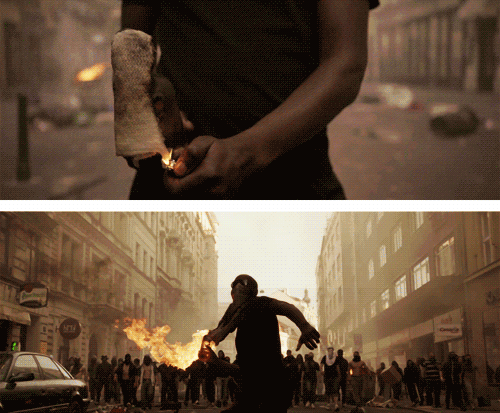First they released “Ni**as In Paris””, and if you have heard Yasiin Bay’s rendition of that track, then you know why the original was problematic. Now Jay-Z and Kanye West debut the video to their most recent single “No Church in the Wild” from their Watch the Thrones album.
Directed by Romain Gavras – whose gritty cinematography has helped him acquire international recognition – has now produced an epic portrayal of a Hobbesian state of nature. Like M.I.A.’s “Born Free” video, “No Church in the Wild” highlights Gavras’ style for glossy, yet raw depictions of sociopolitical struggles.
The reel opens with a young black man lighting a molotov cocktail and turning to hurl it towards a line of riot police. Behind him we see an army of mainly white male protesters fast-approaching and ready to fight them. What unfurls between the riot police and protestors is an episode of grand manichean violence. Prague’s historical architectural sites and statues serve as the backdrop in which the unrelenting violence, vandalism and rioting unfolds.

Though the video is aesthetically appealing, it is the decontextualized realism of the violence and de-territorialization of geography that concerns me. Considering the real life and life-threatening struggles that many around the globe are currently engaged in, I wonder how we are to interpret this video? Particularly in contrast to current and actual footage recorded of children being massacred by oppressive regimes and its rogue officers? I question whether Jay-z, West or even Gavras are trying to deliver a message or align themselves with a particular struggle(s) with the timely release of the video? Or should we simply see this an artistic production remaining faithful to traditional and patriarchal interpretations of violence?
Spin Magazine’s Marc Hogan says, “This fascinating video […] might be like Jay’s short-lived “Occupy All Streets” T-shirts, or West’s quiet Occupy Wall Street visit: Nobody knows what it means, but it’s provocative.” At least for Gavras, this seems to be an artistic goal: to be provocative but not controversial. When asked to elaborate on his artistic vision for Justice’s music video, Gavras tells Interview Magazine, “I didn’t try to do something controversial, otherwise I would have put whores and Nazis in it […] The idea was to make a really violent video to match the music. It’s shot in a realistic way. Lots of people thought it was true.”
But if the point is to be provocative, what are we to make of the Keffiyeh-wearing protestors, the Greek-statues burying their heads in their hands (minute 1:14), the majestic elephant roaring on its hind legs, and the confrontation between the Manicheans? Should we disregard the gratuitous use of violence, and the fact that there is no political context or tools for critical analysis provided to the viewer? Is “No Church in the Wild” commentary on how people fetishize and align themselves with current struggles for which they have little to no understanding about? Or is the video nothing more than highly successful and creative artists fetishizing how they and/or the protest muscle would act during a confrontation with “the system”?
There are no definite answers and the video will remain oblique unless any blunt commentary is offered by the artists or its producer. However, there was somewhat of a consensus reached on my facebook wall when I asked friends to express their viewpoints on the video. Here is what a few of them had to say:
Neal Patterson: “Gavras’s work is beautiful as always, but the overwhelmingly male spectacle (especially towards the end where it looks like a stadium concert) makes it look like they’re using revolution to sell their music instead of using music to sell revolution.”
Sarah-Ji: “Are there any women in this video?”
Michelle Lugalia Hollon: Did [Jay-Z and Kany West] say they were doing it for the people? I think we give celebrities too much “conscious” credibility. They may have done this because it’s just cool to them. Based on that assumption, I actually think it’s beautiful to watch. The sooner we decide to stop projecting these expectations on these two (Watch the Throne was not about anything but them and their thoughts) or others (unless they make such statements) the better.
Paul Weiskel: This just fits into the historical cycle of music and culture reflecting what is going on in society. Kanye, Jay-z, and Romain Gavras are too talented and passionate about their art for this to just be pandering or using revolution to sell music but at the same time there is no easily discernible political statement from the video or song itself. The question to ask coming out of this is whether or not this will become a trend in the entertainment industry.